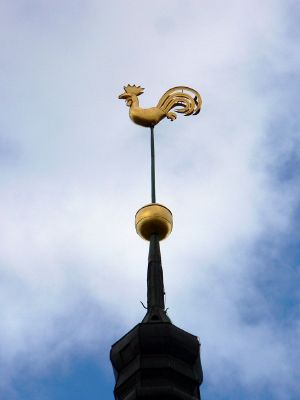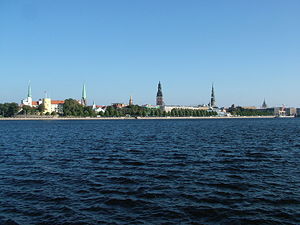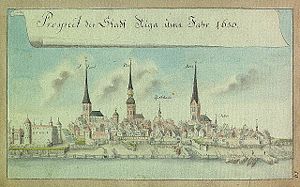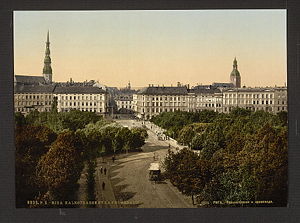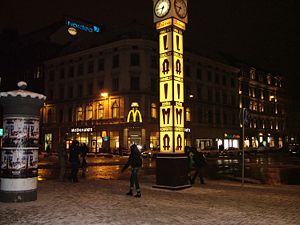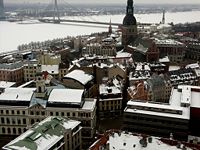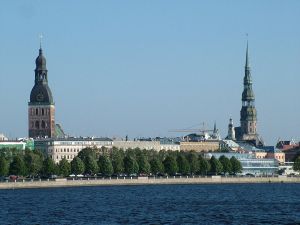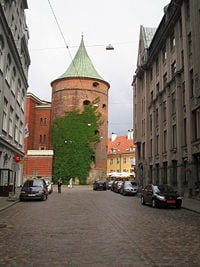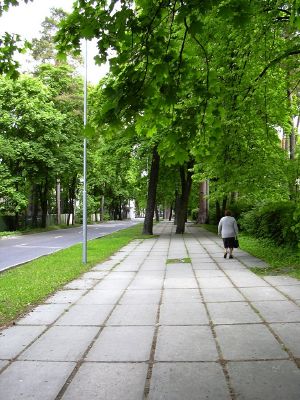Riga, Latvia
| Rīga | |
90px 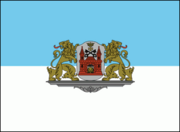
| |
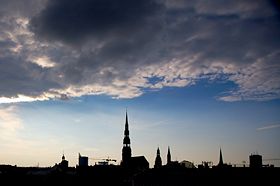
| |
| View of the old town | |
| City rights | 1201 |
|---|---|
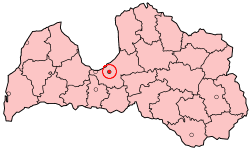
| |
| Location of Rīga within Latvia | |
| Location | 56°58′N 24°8′E |
| Other names | Estonian: Riia; Finnish: Riika; Irish: Ríge; Lithuanian: Ryga; Russian: Рига; Polish: Ryga |
| Mayor | Jānis Birks |
| Area | 307.17 km² (119 sq mi) |
| Water | 48.50 km² (19 sq mi) |
| Population | 727,578 |
| Metropolitan | 1,148,003 |
| Density | 2,382/km² (6,169/sq mi) |
| Postal code | LV-10(01-84) |
| Calling code | +371 7 |
| Time zone | EET (UTC+2) |
| Summer (DST) | EEST (UTC+3) |
| Homepage of Rīga | |
Riga the capital of Latvia, is situated on the Baltic Sea coast on the mouth of the river Daugava. Riga is the largest city in the Baltic states. The Historic Centre of Riga has been declared a UNESCO World Heritage Site, and the city is particularly notable for its extensive Art Nouveau (Jugendstil) architecture, which UNESCO considers to be unparalleled anywhere in the world [1]
History
Geography
Riga is located at 56° 58′ North and 24° 8′ East covering approximately 119 square miles (307 square kilometers).
Riga, the largest city of the Baltic States, is located on the southern shores of the Baltic Sea at the mouth of the Daugava River. The city's location, between Eastern and Western Europe, has been both a help and a hinderance to the city. It's strategic location made it aa important part of the Russian trade with Western Europe, but has also subjected it to invasion and occupation throught it 800 year history. Riga is situated on a sandy plain 9 miles (15 kilometers) from the mouth of the River Daugava and the Gulf of Riga.
Climate
Riga's close proximity to the sea results in a moderate climate with cloud cover for approximately 40 percent of the year. This maritime influence also results in higher humidity (80%) compared to the inland areas. Summers are short and cool with average July temperatures around 64°F (18°C). Winters are long, dark and cold, with January temperatures averaging around 28°F (-2°C). Snowfall is heavy and cover usually lasts from mid-December to mid-March. Total annual precipitation, including rain and snow, is 25 inches (636 millimeters).[2]
Governance
As the federal capital of the Republic of Latvia, Riga is home to both the Federal government and their local city or municipal government.
Federal
The 100-seat unicameral Latvian parliament, the Saeima, is elected by direct, popular vote every four years. The president is elected by the Saeima in a separate election also every four years. The president appoints a prime minister who, together with his cabinet, forms the executive branch of the government, which has to receive a confidence vote by the Saeima.[3]
Municipal
After independence from the Soviets in 1991, the Riga City Council became responsible for running the city. The Riga City Council (RCC) consists of 60 councillors elected to 4-year terms. Elections are held on the second Saturday in March. The number of councillors from each area is proportionate to the number of residents.[4]
Riga is divided into 6 administrative districts: Centra, Kurzemes, Latgales, Vidzemes, Zemgales, and Ziemelu.
Economy
Since regaining its independence in 1991, the city of Riga has attempted to create an open Western style economy that complies with EU standards. Immediately following separation from the Soviet Union in 1991, Riga suffered economic recession, but has managed to stabilize it's economic situation and achieve positive growth rate in 1996 (GDP growth was 2.8 percent). GDP is expected to continue to grow by approximately 5% in 2002 and the following years. Inflation has been considerably reduced and is expected to be less than 3 per cent a year. Policies fostering privatisation and the improvement of the investment climate, have contributed to increased foreign investments in the Riga area. Riga accounts for 49% of the total industrial output of Latvia.
Riga's industries include machine building, metalworking, shipbuilding and repair, textiles, woodworking and food processing. Manufacturing includes diesel engines, streetcars, chemicals, pharmaceuticals, furniture, electrical apparatus, radio and telephone equipment, meteorological instruments, printing and publishing, textiles, building materials, and paper.[5]
Recently, Riga has become the largest financial center in the Baltic Region with major banks, insurance companies and brokers located in the city. Retail trade and personal services was the first sector to show signs of recovery in the early 1990's. Wholesale and retail sales have increased from 8.7 percent of Latvia's GDP in 1994 to 16 percent in 2000. This trend is usually indicative of a growing level of consumption and an increase in the overall health of an economy.[6]
Demographics
With 722,485[7] inhabitants residing in 332,000 households[8], Riga is the largest city in the Baltic States, though its population has been on the decrease since 1991.[7] Notable causes include out-migration and low fertility rates. Some have estimated that the population may fall by as much as 50% by 2050.[9] According to the 2007 data, native Latvians make up 42.3% of the population of Riga, with the percentage of Russians at 42.1%, Belarusians at 4.4%, Ukrainians at 3.9%, Poles at 2.0%, and others at 4.3%.[10] By comparison, 59% of Latvia's inhabitants are native Latvians, 28.5% are Russians, 3.8% are Belarusians, 2.5% are Ukrainians, 2.4% are Polish, 1.4% are Lithuanians and the remaining 2.4% are accounted for by other nationalities (2006).[10] Upon restoration of Latvian independence in 1991, Soviet-era migrants (and any of their offspring born before 1991) were not automatically granted Latvian citizenship. Some have emigrated; this partially accounts for the recent decline in Riga's population. As a result of this repatriation of some Soviet-era migrants, the proportion of Latvians in Riga has increased from 36.5% in 1989 to 42.3% in 2007. In contrast the percentage of Russians has fallen from 47.3% to 42.1% in the same time period. Latvians overtook Russians as the largest ethnic group in 2006. [11]
Riga accounts for approximately one-third of Latvia's population.
Education
Culture
Arts and entertainment
Religion
The three largest faiths were Lutheranism, Roman Catholicism, and Orthodox Christianity. Denominational membership statistics were self-reported estimates and were not completely precise. Sizeable religious minorities included Baptists, Pentecostals, and various evangelical Protestant groups. The once large Jewish community was virtually destroyed in the Holocaust during the 1941-1944 German occupation; the community was an estimated 6,000 to 13,500 persons during the reporting period.
As of April 2006, the Board of Religious Affairs had registered 1,174 congregations. This total included: Lutheran (303), Roman Catholic (250), Orthodox (118), Baptist (93), Old Believer Orthodox (67), Seventh-day Adventist (50), Jehovah's Witnesses (13), Methodist (13), Jewish (13), Buddhist (4), Muslim (15), Hare Krishna (11), Church of Jesus Christ of Latter-day Saints (Mormons) (4), and more than 100 other congregations.
Anti-Semitism In 2003, vandals overturned tombstones and sprayed anti-Semitic graffiti on the walls of Riga's New Jewish Cemetery. National leaders condemned the act and city authorities quickly repaired the damage. Similar desecrations, although on a much smaller scale, occurred in both 2004 and 2005, with similar reactions from leading local citizens. In the spring of 2005, the Orthodox rabbi of Riga was accosted, threatened, and subjected to violently anti-Semitic epithets in Old Town Riga. In late 2005, during the Jewish Hanukkah holiday, vandals deliberately knocked over and broke a large outdoor menorah in Riga.
In early 2006, a law was proposed that would return approximately 200 properties to the Jewish community. The proposal would create a centralized list of all the contested properties and the compensation requested for each item. The Jewish community and the Government continued productive discussions on this issue. By prenegotiating the properties, the community hoped to expedite the legislative process. The Jewish community was optimistic regarding a favorable outcome.
The constitution provides for freedom of religion, and the Government generally respected this right in practice. However, bureaucratic problems persisted for some minority religions. There is no state religion; however, the Government distinguishes between "traditional" (Lutheran, Roman Catholic, Orthodox, Old Believers, Baptists, and Jewish) and "new" religions. In practice, this has not resulted in government discrimination against any particular religion.
Jews are considered an ethnic group and can be listed as such in passports, rather than as Latvian or Russian. [12]
Infrastructure
Health
Transport
Utilities
Business and commerce
Business and leisure travel to Riga has increased significantly in recent years due to improved infrastructure. Riga as a city-port is a major transportation hub and is the center of the local road and railway system. Most tourists travel to Riga by air via Riga International Airport, the largest airport in the Baltic states, which was renovated and modernized in 2001 on the occasion of Riga's 800th anniversary. Air traffic at the airport has doubled between 1993 and 2004. Baltic sea ferries connect Riga to Stockholm, Kiel and Lübeck. Riga was also home to two air bases during the Cold War: Rumbula and Spilve.
Almost all important Latvian financial institutions are located in Riga, including the Bank of Latvia, which is Latvia's central bank. Foreign commercial trade through Riga has been on the increase in recent years and received new impetus on May 1, 2004 when Latvia became a member of the European Union. Riga accounts for about half of the total industrial output of Latvia, focusing on the financial sector, public utilities, food and beverages, pharmaceuticals, wood processing, printing and publishing, textiles and furniture, and communications equipment manufacturing. More than 50% of Latvian companies are registered in Riga region.[13] The port of Riga is an important cargo shipping center.
History
| Historic Centre of Riga* | |
|---|---|
| UNESCO World Heritage Site | |
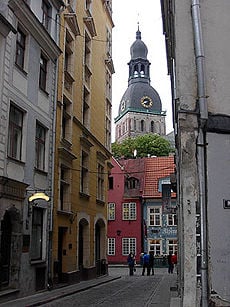
| |
| Type | Cultural |
| Criteria | i, ii |
| Reference | 852 |
| Region** | Europe and North America |
| Inscription history | |
| Inscription | 1997 (21st Session) |
| * Name as inscribed on World Heritage List. ** Region as classified by UNESCO. | |
Riga is located at the site of an ancient settlement of the Livonians, an ancient Finnic tribe, at the junction of the Daugava and Ridzene (Latvian: Rīdzene) rivers. The Ridzene was originally known as the Riga River, at one point forming a natural harbor called the Riga Lake, neither of which exist today [14]. Some believe that the name of the river gave Riga its name.[citation needed]
The modern founding of Riga is regarded by historians to have begun with the arrival in Latvia of German traders, mercenaries and religious crusaders in the second half of the 12th century, attracted by a sparsely populated region, potential new markets and by the missionary opportunities to convert the local population to Christianity. German merchants established an outpost for trading with the Balts near the Liv settlement at Riga in 1158. The Augustinian monk Meinhard built a monastery there ca. 1190.
Bishop Albert was proclaimed Bishop of Livonia by his uncle Hartwig, Archbishop of Bremen and Hamburg in 1199. He landed in Riga in 1201 with 23 ships and more than 1500 armed crusaders, making Riga his bishopric. He established the Order of Livonian Brothers of the Sword (later a branch of the Teutonic Knights) and granted Riga city rights in that same year. Albert was successful in converting the King of the Livs, Caupo of Turaida, to Christianity, although, as related in the Chronicle of Henry of Livonia ("Henricus Lettus"), it took him three decades to gain full control of Livonia (German Livland). Riga as well as Livonia and Prussia came under the auspices of the Holy Roman (German) Empire. It was not until much later, at the time of Martin Luther, that Riga, Livonia and Prussia converted to Protestantism.
Riga served as a gateway to trade with the Baltic tribes and with Russia. In 1282 Riga became a member of the Hanseatic League (German Hanse, English Hansa). The Hansa developed out of an association of merchants into a loose trade and political union of North German and Baltic cities and towns. Due to its economic protectionist policies which favored its German members, the League was very successful, but its exclusionist policies produced competitors. Its last Diet convened in 1669, although its powers were already weakened by the end of the 14th century, when political alliances between Lithuania and Poland and between Sweden, Denmark and Norway limited its influence. Nevertheless, the Hansa was instrumental in giving Riga economic and political stability, thus providing the city with a strong foundation which endured the political conflagrations that were to come, down to modern times.
As the influence of the Hansa waned, Riga became the object of foreign military, political, religious and economic aspirations. Riga accepted the Reformation in 1522, ending the power of the archbishops. In 1524, a venerated statue of the Virgin Mary in the Cathedral was denounced as a witch, and given a trial by water in the Daugava or Dvina River. The statue floated, so it was denounced as a witch and burnt at Kubsberg[15]. With the demise of the Teutonic Knights in 1561, Riga for twenty years had the status of a Free Imperial City, then in 1581, Riga came under the influence of the Polish-Lithuanian Commonwealth. Attempts to reinstitute Roman Catholicism in Riga and southern Livonia failed as in 1621, Riga and the outlying fortress of Daugavgriva came under the rule of Gustavus Adolphus, King of Sweden, who intervened in the Thirty Years' War not only for political and economic gain but also in favor of German Lutheran Protestantism. During the Russo-Swedish War, 1656-1658, Riga withstood a siege by Russians. Riga remained the second largest city under Swedish control until 1710 during a period in which the city retained a great deal of self-government autonomy. In that year, in the course of Great Northern War, Russia under Tsar Peter the Great invaded Riga. Sweden's northern dominance ended, and Russia's emergence as the strongest Northern power was formalized through the Treaty of Nystad in 1721. Riga was annexed by Russia and became an industrialized port city of the Russian empire, where it remained until World War I. By 1900, Riga was the third largest city in Russia after Moscow and St. Petersburg in terms of numbers of industrial workers.
During these many centuries of war and changes of power in the Baltic, the Baltic Germans in Riga, successors to Albert's merchants and crusaders, clung to their dominant position despite demographic changes. Riga even employed German as its official language of administration until the imposition of Russian language in 1891 as the official language in the Baltic provinces. All birth, marriage and death records were kept in German up to that year. Latvians began to supplant Germans as the largest ethnic group in the city in the mid-19th century, however, and by 1897 the population was 45% Latvian (up from 23.6% in 1867), 23.8% German (down from 42.9% in 1867), 16.1% Russian, 6% Jewish, 4.8% Polish, 2.3% Lithuanian, and 1.3% Estonian.[citation needed] The rise of a Latvian bourgeoisie made Riga a center of the Latvian National Awakening with the founding of the Riga Latvian Association in 1868 and the organization of the first national song festival in 1873. The nationalist movement of the Young Latvians was followed by the socialist New Current during the city's rapid industrialization, culminating in the 1905 Revolution led by the Latvian Social Democratic Workers' Party.
The 20th century brought World War I and the impact of the Russian Revolution to Riga. The German army marched into Riga in 1917. In 1918 the Treaty of Brest-Litovsk was signed giving the Baltic countries to Germany. Because of the Armistice with Germany (Compiègne) of November 11, 1918, Germany had to renounce that treaty, as did Russia, leaving Latvia and the other Baltic States in a position to claim independence.
After more than 700 years of German, Swedish, Russian rule, Latvia, with Riga as its capital city, thus declared its independence on November 18, 1918. For more details, see History of Latvia.
Between World War I and World War II (1918–1940), Riga and Latvia shifted their focus from Russia to the countries of Western Europe. A democratic, parliamentary system of government with a President was instituted. Latvian was recognized as the official language of Latvia. Latvia was admitted to the League of Nations. The United Kingdom and Germany replaced Russia as Latvia's major trade partners. As a sign of the times, Latvia's first Prime Minister, Kārlis Ulmanis, had studied agriculture and worked as a lecturer at the University of Nebraska in the United States of America.
Riga was described at this time as a vibrant, grand and imposing city and earned the title of "Paris of the North" from its visitors.
This period of rebirth was short-lived, however. Democracy faltered, and in 1934, Ulmanis staged a coup d´état that installed an authoritiarian regime. There then followed World War II, with the Soviet occupation and annexation of Latvia in 1940, German occupation in 1941-1944. The Baltic Germans were forcibly repatriated to Germany at Hitler's behest, after 700 years in Riga. The city's Jewish community was forced into a ghetto in the Maskavas neighbourhood, and concentration camps were constructed in Kaiserwald and at nearby Salaspils.
Nazism was defeated, but the effects of the war were lasting. Aside from the destruction is wrought, the war cost Latvia dearly. Hundreds of thousands of her citizens had perished and tens of thousands fled into exile in countries all over the world. As a result of World War II, Latvia lost approximately one-third of its population.
Furthermore, instead of re-established independence, in 1945 Latvia was once again subjected to Soviet domination. Many Latvians were deported to Siberia and other regions of the Soviet Union, usually bineg accused of having collaborated with the Nazis or of supporting the post-war anti-Soviet Resistance. Forced industrialization and planned large-scale immigration of large numbers of non-Latvians from other Soviet republics into Riga, particularly Russians, changed the demographic composition of Riga. High-density apartment developments, such as Purvciems, Zolitude, and Ziepniekkalns ringed the city's edge, linked to the center by electric railways. By 1975 less than 40% of Riga's inhabitants were ethnically Latvian, a percentage which has risen since Latvian independence.
In 1986 the modern landmark of Riga, the Riga Radio and TV Tower, whose design is reminiscent of the Eiffel Tower,[citation needed] was completed.
The policy of economic reform introduced as Perestroika by Soviet leader Mikhail Gorbachev led to a situation in the late 1980s in which many Soviet republics, including Latvia, were able to regain their liberty and freedom (see Latvia). Latvia declared its full de facto independence on August 21, 1991 and that independence was recognized by Russia on September 6, 1991. Latvia formally joined the United Nations as an independent country on September 17, 1991. All Russian military forces were removed from 1992 to 1994.
- In 2001, Riga celebrated its 800th anniversary as a city.
- On March 29, 2004 Latvia joined NATO.
- On May 1, 2004 Latvia joined the European Union.
In 2004, the arrival of low-cost airlines resulted in cheaper flights from other European cities such as London and Berlin and consequently a substantial increase in numbers of tourists. [16] However concerns have been expressed about the misbehaviour of some groups of tourists after two British tourists were caught urinating in Freedom Monument Square[17] prompting the British embassy to issue advice to tourists to behave in a responsible way when drinking. [18] The number of tourists has continued to increase and 2006 saw an 18% rise in the number of people staying in Latvian hotels relative to 2005, the largest increase in the E.U. and well above the European average of 2.4%. [19]
Sights
- The Doma Cathedral, considered the largest church in the Baltic states. Built in the 13th century, it was modified several times in its history. It has a magnificent organ that dates from 1844.
- Riga Castle (Rīgas Pils), which houses the Museum of Latvian History and the Museum of Foreign Art.
- St. Peter's Church, with its 123 m (404 ft) high tower.
- St. John's Church, a small 13th-century chapel, behind St. Peter's Church.
- The Powder Tower (Pulvertornis), the only tower that remains from the original city walls. The Latvian Museum of War is located inside.
- Wooden architecture open air museum.
- The Occupation Museum of Latvia, which documents the seizure and occupation of Latvia by different forces from 1918 to 1991.
- Art Nouveau architecture on Central Riga streets such as Alberta and Elizabetes Iela.
- Riga Radio and TV Tower - the third highest tower in Europe.
- Motormuzejs (Motormuseum) - collection of retro automobiles, including some historically significant autos, for example, Brezhnev's and Stalin's limousines with waxworks of these political figures. Located in Mežciems.
- Riga Zoo and Mežaparks(Forest Park) with a Ferris wheel.
- Domina Shopping Centre - the largest shopping centre in the Baltic states (located in the North-West side of Purvciems).
- Riga Circus - the only stationary circus in the Baltic States.
Development and future
In the near future, the face of Riga will undergo notable changes. In 2008, the first stage of the new Southern Bridge route across the Daugava will be completed.[20] The Southern Bridge is currently the biggest construction project in Latvia, and will help to reduce traffic jams and the amount of traffic in the city centre.[21] An another big construction project is the planned Riga Northern Transport Corridor,[22] which is scheduled to start in 2010. The construction of a new landmark — the Latvian National Library building — is beginning in the autumn of 2007 and is due to be built by 2010.[23] Currently discussions are underway in Riga council about the development of the central areas on the left bank of the Daugava. The major dispute surrounds plans to build skyscrapers in Ķīpsala.[citation needed] The construction of 3 buildings in Ķīpsala has already started — the Da Vinci complex (25 floors, construction stopped) and two high-rises called Z-Towers (30 floors).[24][25]
Riga's neighbourhoods
The city of Riga consists of six administrative regions, four of which are named after regions of Latvia - Kurzeme district, Latgale suburb, Vidzeme suburb, Zemgale suburb. There is also a Central District and a Northern district. Residents, however, divide Riga into residential neighbourhoods called micro regions. Unlike the city center, they are mostly residential although they are equipped with commercial sectors. These neighbourhoods include:
- Āgenskalns - Left bank, old neighbourhood, mainly built in late 19th - early 20th century.
- Andrejsala - An emerging art, culture and enterteinment district, located within former territory of the industrial port.
- Beberbeķi - A neighbourhood consisting mainly of private houses, it lies on the western edge of the city. Swampy forest Mukupurvs and Riga Airport noise area devides it from the rest of the city.
- Bolderāja - Left bank, Northernmost neighbourhood. 18th century fort bilt by Peter the Great is one of the oldest buildings in this part of the city.
- Čiekurkalns - Right bank, old neighbourhood.
- Dārzciems - Right bank, mainly consists of one- or two-story private houses.
- Dreiliņi - A newly built neighbourhood in the eastern part of the city.
- Dzirciems - Left bank, South of Iļģuciems.
- Iļģuciems - Left bank, North of Āgenskalns.
- Imanta - Left bank, newly-built neighbourhood.
- Jugla - Right bank, large neighbourhood, lies just West of lake Juglas.
- Ķengarags - Right bank, South-East of city center. One of the most inhabited neighbourhoods in town.
- Ķīpsala - island located just West of the Old Town. Home to The Press Office and Exhibition Hall.
- Maskavas Forštate - located South of the city centre.
- Mežaparks - Right bank, consists largely of private houses. Notable for it's large forest-like park and the city zoo.
- Mežciems - Right bank, just East of large Biķernieku forest.
- Pārdaugava - Not really a neighbourhood by itself, but the name is frequently used when talking about Left bank, particularly Āgenskalns and Torņakalns.
- Pleskodāle - A neighbourhood consisting mostly of private houses on the west side of the city. It borders Zolitūde and Šampēteris neighbourhoods.
- Pļavnieki - Right bank, one of the town's most inhabited neighbourhoods.
- Purvciems - Right bank.
- Sarkandaugava - Right bank, East of the small river with the same name.
- Šampēteris - An old neighbourhood on the best bank of Daugava, with many houses built in the first part of 20th century still surviving.
- Šmerlis - Right bank, more of a forest than a neighbourhood, it is home to Riga's Cinema Studio.
- Torņakalns - Left bank, old neighbourhood known for the Māras pond.
- Vecmīlgrāvis - Right bank, cut off the mainland by a small river, Mīlgrāvis.
- Vecrīga - Old Town.
- Ziepniekkalns - Left bank, consists both of old and new buildings.
- Zolitūde - Left bank, another newly-built neighbourhood, just South of Imanta.
Some common factors in these place names are "vec" meaning old [vecs], "kalns" meaning hill, "ciems" meaning village, "sala" meaning island and "mež" meaning forest [mežs].
Sister cities
Riga maintains sister city relationships with the following cities:
Notes
- ↑ Unesco World Heritage ListRiga (Page 67) Retrieved November 24, 2007.
- ↑ Globe Media Ltd. Riga Retrieved November 24, 2007.
- ↑ (Latvian)Constitution of the Republic of Latvia with amendments and revisions (Official english translation) (Retrieved on 24 December 2006)
- ↑ Municipality of Riga Riga City Council Retrieved november 24, 2007.
- ↑ The Columbia Electronic Encyclopedia, Sixth Edition Riga Retrieved November 24, 2007
- ↑ Cities Environment Reports on the Internet Riga City Environment Centre "Agenda 21" Retrieved November 24, 2007.
- ↑ 7.0 7.1 Central Statistical Bureau of Latvia Resident Population by Region Retrieved November 24, 2007.
- ↑ Cities Environment Reports on the Internet Population Retrieved November 24, 2007.
- ↑ Heleniak, Timothy (February 2006). Latvia Looks West, But Legacy of Soviets Remains. University of Maryland. Retrieved 2007-08-02.
- ↑ 10.0 10.1 Riga in Figures. Riga City Council. Retrieved 2007-08-02.
- ↑ RESIDENT POPULATION BY ETHNICITY AT THE BEGINNING OF THE YEAR.
- ↑ U.S. Embassy Riga, LatviaInternational Religious Freedom Report - Latvia, 2006 Retrieved November 24, 2007.
- ↑ Lursoft IT statistics on dynamics of registering of companies in regions of Latvia. Retrieved 2007-09-25.
- ↑ Teritorija un administratīvās robežas vēsturiskā skatījumā (in Latvian). Cities Environmental Reports on the Internet. Retrieved 2007-08-02.
- ↑ MacCulloch, Diarmaid (2003). The Reformation: A History. Penguin. ISBN 0-670-03296-4.
- ↑ Charles, Jonathan, "Latvia prepares for a tourist invasion", BBC News, 2005-06-30. Retrieved 2007-08-02.
- ↑ "UK tourist urinates in Freedom Monument square", The Baltic Times, 2007-05-21. Retrieved 2007-08-02.
- ↑ "British embassy warns tourists in Latvia: think before you drink", Monsters and Critics, 2007-03-15. Retrieved 2007-08-02.
- ↑ Baltic Outlook, August 2007, p56
- ↑ About the South Bridge. Riga City Council. Retrieved 2007-08-21.
- ↑ Southern Bridge project homepage. Retrieved 2007-08-21.
- ↑ About the Northern Corridor. Retrieved 2007-08-21.
- ↑ About the construction of the Castle of Light. Latvian National Library. Retrieved 2007-08-21.
- ↑ Da Vinci project info. Emporis Buildings. Retrieved 2007-08-21.
- ↑ Z-Towers project description. Vertikala Pasaule. Retrieved 2007-08-21.
Sources and further reading
External links
Credits
New World Encyclopedia writers and editors rewrote and completed the Wikipedia article in accordance with New World Encyclopedia standards. This article abides by terms of the Creative Commons CC-by-sa 3.0 License (CC-by-sa), which may be used and disseminated with proper attribution. Credit is due under the terms of this license that can reference both the New World Encyclopedia contributors and the selfless volunteer contributors of the Wikimedia Foundation. To cite this article click here for a list of acceptable citing formats.The history of earlier contributions by wikipedians is accessible to researchers here:
The history of this article since it was imported to New World Encyclopedia:
Note: Some restrictions may apply to use of individual images which are separately licensed.
